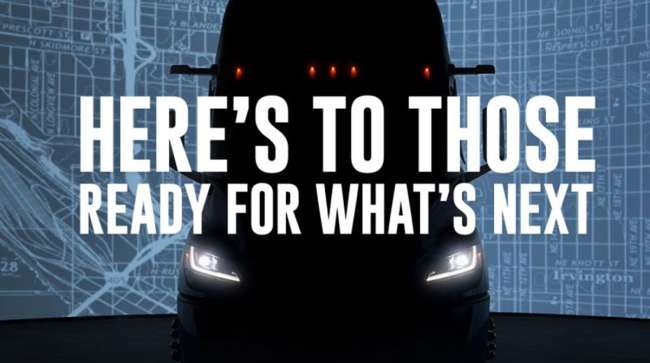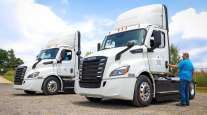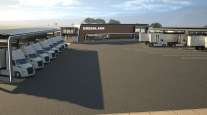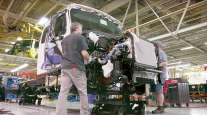Staff Reporter
Freightliner Teases Debut of Fifth Generation Cascadia

[Stay on top of transportation news: Get TTNews in your inbox.]
Freightliner teased an Oct. 15 unveiling of a revamp of its flagship Class 8 on-highway Cascadia model Oct. 1.
The top-ranked Class 8 original equipment manufacturer by sales provided a silhouette of a fifth-generation Cascadia ahead of the upcoming launch in a LinkedIn post.
Outlined against a background of a street map of Portland, Ore., hometown of parent company Daimler Truck North America and Freightliner, the silhouette indicates a more aerodynamic shape, promises enhanced safety or autonomous driving features with horizontal sensor array housings, and emphasizes the shape of the headlights.
“Generation after generation. Innovation after innovation. We focus on delivering for our customers. Here’s to those who know the future starts with them! Join us on October 15th as we unveil the fifth generation Cascadia,” the DTNA unit wrote.
Freightliner then invited those interested to submit their details for updates.
Cascadia Timeline
2007: Cascadia debuts, replacing the Century and Columbia models. Detroit Diesel DD15 engine platform introduced.
2012: Second generation launches, introducing the Detroit DT12 automated transmission.
2017: Third generation announced. Enhancements include reconfigured driver loft and greater connectivity.
2019: Fourth generation brings SAE Level 2 capabilities, with automated software capable of both lateral (steering) and longitudinal (acceleration/deceleration) control.
2022: Battery-electric version of its flagship model, the eCascadia, is unveiled at ACT Expo.
2024: Fifth generation of the Cascadia to launch Oct. 15.
It is five years since the last iteration of the Cascadia launched in 2019, when the fourth generation was unveiled.
The previous launch introduced SAE Level 2 capabilities, with automated software capable of both lateral (steering) and longitudinal (acceleration/deceleration) control.
Level 2 automation allows the truck, with a driver in the cab, to independently steer, accelerate and brake.
Freightliner’s Detroit Assurance 5.0 platform fused radar and camera information, with lane departure protection and lane keep assist required for Level 2 driving.
Since then, Freightliner introduced a battery-electric version of its flagship model, the eCascadia, in 2022 at the Advanced Clean Transportation Expo.
Just ahead of the ACT 2024 conference in May, the truck maker unveiled plans for an autonomous, battery-electric eCascadia demonstration truck using Torc Robotics’ autonomous driving software plus Level 4 sensor and computing technology. Torc Robotics is Daimler Truck’s independent self-driving technology unit.
Such technology was far beyond the freight industry’s radar when the initial version of the Cascadia debuted in 2007.
The Cascadia replaced the Century and Columbia models at a development cost of $400 million, debuted the heavy-duty Detroit Diesel DD15 engine platform, and was available with automatic or automated transmission options.
Freightliner’s second-generation Cascadia, launched in 2012, saw the introduction of the Detroit DT12, an automated manual transmission. At the time, 85% of on-highway customers ordered a manual transmission.
Five years later, the third-generation Cascadia was introduced in 2017, with a reconfiguration of the driver loft and greater connectivity.
Want more news? Listen to today's daily briefing below or go here for more info:




